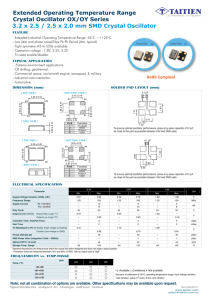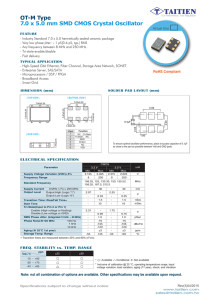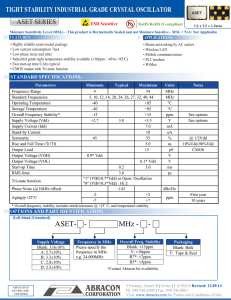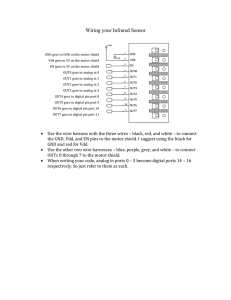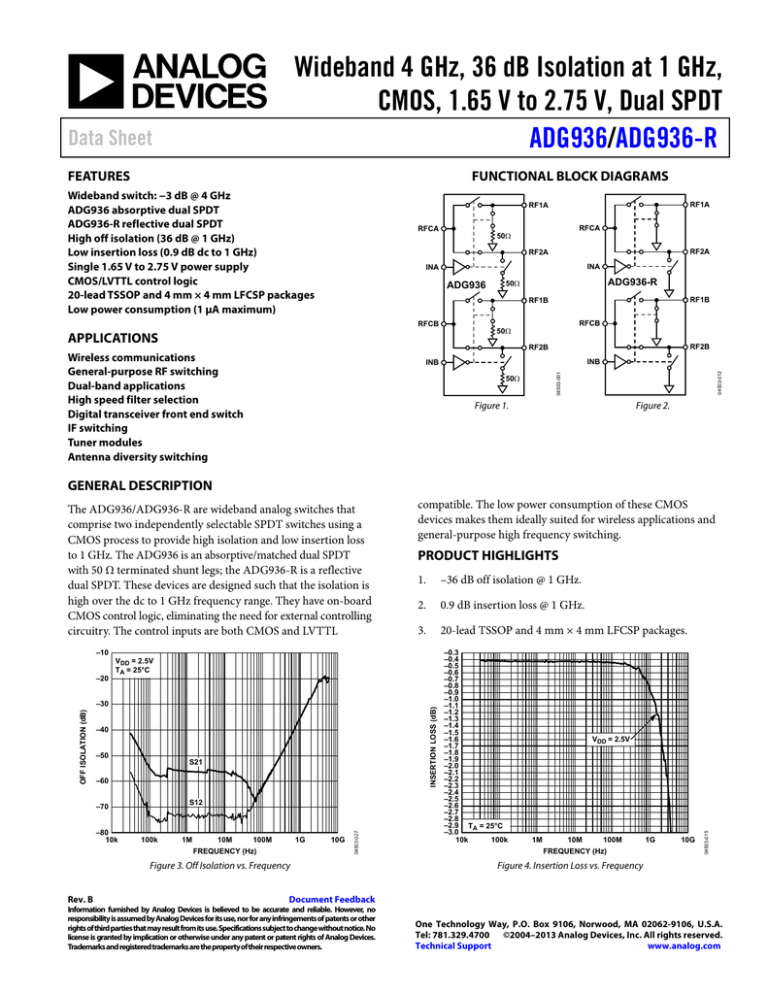
Wideband 4 GHz, 36 dB Isolation at 1 GHz,
CMOS, 1.65 V to 2.75 V, Dual SPDT
ADG936/ADG936-R
Data Sheet
FUNCTIONAL BLOCK DIAGRAMS
FEATURES
Wideband switch: −3 dB @ 4 GHz
ADG936 absorptive dual SPDT
ADG936-R reflective dual SPDT
High off isolation (36 dB @ 1 GHz)
Low insertion loss (0.9 dB dc to 1 GHz)
Single 1.65 V to 2.75 V power supply
CMOS/LVTTL control logic
20-lead TSSOP and 4 mm × 4 mm LFCSP packages
Low power consumption (1 μA maximum)
RF1A
RF1A
RFCA
RFCA
50
RF2A
RF2A
INA
INA
ADG936
ADG936-R
50
RF1B
RF1B
RFCB
RFCB
50
APPLICATIONS
RF2B
RF2B
INB
04503-001
INB
04503-012
Wireless communications
General-purpose RF switching
Dual-band applications
High speed filter selection
Digital transceiver front end switch
IF switching
Tuner modules
Antenna diversity switching
50
Figure 1.
Figure 2.
GENERAL DESCRIPTION
compatible. The low power consumption of these CMOS
devices makes them ideally suited for wireless applications and
general-purpose high frequency switching.
PRODUCT HIGHLIGHTS
1.
–36 dB off isolation @ 1 GHz.
2.
0.9 dB insertion loss @ 1 GHz.
3.
20-lead TSSOP and 4 mm × 4 mm LFCSP packages.
–10
–20
VDD = 2.5V
TA = 25°C
INSERTION LOSS (dB)
–40
–50
S21
–60
S12
–70
–80
10k
100k
1M
10M
100M
FREQUENCY (Hz)
1G
10G
04503-027
OFF ISOLATION (dB)
–30
Figure 3. Off Isolation vs. Frequency
Rev. B
–0.3
–0.4
–0.5
–0.6
–0.7
–0.8
–0.9
–1.0
–1.1
–1.2
–1.3
–1.4
–1.5
–1.6
–1.7
–1.8
–1.9
–2.0
–2.1
–2.2
–2.3
–2.4
–2.5
–2.6
–2.7
–2.8
–2.9 TA = 25°C
–3.0
10k
100k
VDD = 2.5V
1M
10M
100M
FREQUENCY (Hz)
1G
10G
04503-015
The ADG936/ADG936-R are wideband analog switches that
comprise two independently selectable SPDT switches using a
CMOS process to provide high isolation and low insertion loss
to 1 GHz. The ADG936 is an absorptive/matched dual SPDT
with 50 Ω terminated shunt legs; the ADG936-R is a reflective
dual SPDT. These devices are designed such that the isolation is
high over the dc to 1 GHz frequency range. They have on-board
CMOS control logic, eliminating the need for external controlling
circuitry. The control inputs are both CMOS and LVTTL
Figure 4. Insertion Loss vs. Frequency
Document Feedback
Information furnished by Analog Devices is believed to be accurate and reliable. However, no
responsibility is assumed by Analog Devices for its use, nor for any infringements of patents or other
rights of third parties that may result from its use. Specifications subject to change without notice. No
license is granted by implication or otherwise under any patent or patent rights of Analog Devices.
Trademarks and registered trademarks are the property of their respective owners.
One Technology Way, P.O. Box 9106, Norwood, MA 02062-9106, U.S.A.
Tel: 781.329.4700 ©2004–2013 Analog Devices, Inc. All rights reserved.
Technical Support
www.analog.com
Powered by TCPDF (www.tcpdf.org)
IMPORTANT LINKS for the ADG936_936R*
Last content update 08/17/2013 12:52 am
PARAMETRIC SELECTION TABLES
DESIGN COLLABORATION COMMUNITY
Choosing the Correct Switch or Multiplexer for Your Application
Switches and Multiplexers Product Selection Guide
Collaborate Online with the ADI support team and other designers
about select ADI products.
DOCUMENTATION
AN-952: ADG9xx Wideband CMOS Switches: Frequently Asked
Questions
CN-0211: IF Band-Pass Filter Bank Switching Network for Wireless
Infrastructure
Use Circuits from the Lab™ in Your Next Design
CMOS Switches Offer High Performance in Low Power, Wideband
Applications
RF Source Booklet
Follow us on Twitter: www.twitter.com/ADI_News
Like us on Facebook: www.facebook.com/AnalogDevicesInc
DESIGN SUPPORT
Submit your support request here:
Linear and Data Converters
Embedded Processing and DSP
Telephone our Customer Interaction Centers toll free:
EVALUATION KITS & SYMBOLS & FOOTPRINTS
View the Evaluation Boards and Kits page for the ADG936
View the Evaluation Boards and Kits page for the ADG936-R
Symbols and Footprints
Americas:
Europe:
China:
India:
Russia:
1-800-262-5643
00800-266-822-82
4006-100-006
1800-419-0108
8-800-555-45-90
Quality and Reliability
Lead(Pb)-Free Data
SAMPLE & BUY
ADG936/ADG936-R
View Price & Packaging
Request Evaluation Board
Request Samples Check Inventory & Purchase
Find Local Distributors
* This page was dynamically generated by Analog Devices, Inc. and inserted into this data sheet.
Note: Dynamic changes to the content on this page (labeled 'Important Links') does not
constitute a change to the revision number of the product data sheet.
This content may be frequently modified.
ADG936/ADG936-R
Data Sheet
TABLE OF CONTENTS
Features .............................................................................................. 1
Typical Performance Characteristics ..............................................7
Applications ....................................................................................... 1
Test Circuits........................................................................................9
Functional Block Diagrams ............................................................. 1
Applications..................................................................................... 11
General Description ......................................................................... 1
Absorptive vs. Reflective ........................................................... 11
Product Highlights ........................................................................... 1
Filter Selection ............................................................................ 11
Revision History ............................................................................... 2
Tx/Rx Switching ......................................................................... 11
Specifications..................................................................................... 3
Antenna Diversity Switch .......................................................... 11
Absolute Maximum Ratings ............................................................ 4
Evaluation Board ............................................................................ 12
ESD Caution .................................................................................. 4
Outline Dimensions ....................................................................... 13
Pin Configurations and Function Descriptions ........................... 5
Ordering Guide .......................................................................... 14
Terminology ...................................................................................... 6
REVISION HISTORY
4/13—Rev. A to Rev. B
Changed CP-20-1 to CP-20-6 ........................................... Universal
Added EPAD Note ............................................................................ 5
Updated Outline Dimensions ....................................................... 13
Changes to Ordering Guide .......................................................... 14
8/05—Rev. 0 to Rev. A
Changes to Table 1 ............................................................................ 3
Changes to Figure 6 .......................................................................... 5
Changes to Ordering Guide .......................................................... 14
7/04—Revision 0: Initial Version
Rev. B | Page 2 of 16
Data Sheet
ADG936/ADG936-R
SPECIFICATIONS
VDD = 1.65 V to 2.75 V, GND = 0 V, input power = 0 dBm, all specifications TMIN to TMAX, unless otherwise noted. 1
Table 1.
Parameter
AC ELECTRICAL CHARACTERISTICS
Operating Frequency 3
3 dB Frequency 4
Input Power4
Symbol
tON
tOFF
tRISE
tFALL
P–1 dB
IP3
0 V dc bias
0.5 V dc bias
DC to 100 MHz; VDD = 2.5 V ± 10%
500 MHz; VDD = 2.5 V ± 10%
1000 MHz; VDD = 2.5 V ± 10%
100 MHz
500 MHz
1000 MHz
100 MHz
500 MHz
1000 MHz
DC to 100 MHz
500 MHz
1000 MHz
DC to 100 MHz
500 MHz
1000 MHz
50% CTRL to 90% RF
50% CTRL to 10% RF
10% to 90% RF
90% to 10% RF
1000 MHz
900 MHz/901 MHz, 4 dBm
VINH
VINH
VINL
VINL
II
VDD = 2.25 V to 2.75 V
VDD = 1.65 V to 1.95 V
VDD = 2.25 V to 2.75 V
VDD = 1.65 V to 1.95 V
0 ≤ VIN ≤ 2.75 V
CRF ON
CDIG
f = 1 MHz
f = 1 MHz
IDD
Digital inputs = 0 V or VDD
S21, S12
Isolation—RFCx to RF1x/RF2x
S21, S12
Crosstalk—RF1x to RF2x
S21, S12
Return Loss (On Channel)4
S11, S22
Return Loss (Off Channel)4
S11, S22
Input Low Voltage
Input Leakage Current
CAPACITANCE4
RF Port On Capacitance
Digital Input Capacitance
POWER REQUIREMENTS
VDD
Quiescent Power Supply Current
Min
B Version
Typ 2
DC
Insertion Loss
On Switching Time4
Off Switching Time4
Rise Time4
Fall Time4
1 dB Compression4
Third-Order Intermodulation Intercept
Video Feedthrough 5
DC ELECTRICAL CHARACTERISTICS
Input High Voltage
Conditions
52
40
31
53
42
34
20
19
16
18
17
16
27.5
0.4
0.6
0.9
60
47
36
69
45
37
25
23
24
24
23
21
11
10
6.1
6
16
32
3
Max
Unit
2
4
7
16
0.5
0.8
1.25
GHz
GHz
dBm
dBm
dB
dB
dB
dB
dB
dB
dB
dB
dB
dB
dB
dB
dB
dB
dB
ns
ns
ns
ns
dBm
dBm
mV p-p
14
13
8
8
1.7
0.65 VCC
± 0.1
0.7
0.35 VCC
±1
2.5
2
1.65
0.1
V
V
V
V
µA
pF
pF
2.75
1
V
µA
Temperature range of B Version: −40°C to +85°C.
Typical values are at VDD = 2.5 V and 25°C, unless otherwise noted.
Operating frequency is the point at which insertion loss degrades by 1 dB.
4
Guaranteed by design, not subject to production test.
5
Video feedthrough is the dc transience at the output of any port of the switch when the control voltage is switched from high to low or from low to high in a 50 Ω test
setup, measured with 1 ns rise time pulses and a 500 MHz bandwidth.
1
2
3
Rev. B | Page 3 of 16
ADG936/ADG936-R
Data Sheet
ABSOLUTE MAXIMUM RATINGS
TA = 25°C, unless otherwise noted.
Table 2.
Parameter
VDD to GND
Inputs to GND
Continuous Current
Input Power
Operating Temperature Range
Industrial (B Version)
Storage Temperature Range
Junction Temperature
TSSOP Package
θJA Thermal Impedance
LFCSP Package
θJA Thermal Impedance (4-Layer Board)
Lead Temperature, Soldering (10 sec)
IR Reflow, Peak Temperature (<20 sec)
ESD
Rating
–0.5 V to +4 V
–0.5 V to VDD + 0.3 V 1
30 mA
18 dBm
–40°C to +85°C
–65°C to +150°C
150°C
Stresses above those listed under Absolute Maximum Ratings
may cause permanent damage to the device. This is a stress
rating only; functional operation of the device at these or any
other conditions above those indicated in the operational
section of this specification is not implied. Exposure to absolute
maximum rating conditions for extended periods may affect
device reliability.
Only one absolute maximum rating may be applied at any one
time.
143°C/W
30.4°C/W
300°C
235°C
1 kV
Table 3. Truth Table
INx
0
1
1
RF1x
Off
On
RF2x
On
Off
RF1x/RF2x off port inputs to ground = –0.5 V to VDD – 0.5 V.
ESD CAUTION
ESD (electrostatic discharge) sensitive device. Electrostatic charges as high as 4000 V readily accumulate on
the human body and test equipment and can discharge without detection. Although this product features
proprietary ESD protection circuitry, permanent damage may occur on devices subjected to high energy
electrostatic discharges. Therefore, proper ESD precautions are recommended to avoid performance
degradation or loss of functionality.
Rev. B | Page 4 of 16
Data Sheet
ADG936/ADG936-R
GND
19
INA
18
GND
17
RF2A
GND 5
GND 6
ADG936
ADG936-R
GND
RF1A
GND
GND
RF1B
16 GND
TOP VIEW
(Not to Scale)
15 GND
RF1B 7
14
RF2B
GND 8
13
GND
GND 9
12
INB
RFCB 10
11
GND
1
2
3
4
5
ADG936
ADG936-R
TOP VIEW
(Not to Scale)
15
14
13
12
11
GND
RF2A
GND
GND
RF2B
GND 6
GND 7
RFCB 8
GND 9
INB 10
RF1A 4
04503-002
GND 3
NOTES
1. EXPOSED PAD TIED TO SUBSTATE, GND.
Figure 5. 20-Lead TSSOP (RU-20)
04503-003
20
VDD 2
20
19
18
17
16
RFCA 1
GND
VDD
RFCA
GND
INA
PIN CONFIGURATIONS AND FUNCTION DESCRIPTIONS
Figure 6. 20-Lead 4 mm × 4 mm LFCSP (CP-20-1)
Table 4. Pin Function Descriptions
Pin No.
20-Lead
20-Lead
TSSOP
LFCSP
1
18
2
19
3, 5, 6, 8, 9,
11, 13, 15,
16, 18, 20
4
7
10
12
14
17
19
1, 3, 4, 6, 7,
9, 12, 13,
15, 17, 20
2
5
8
10
11
14
16
EP
Mnemonic
RFCA
VDD
GND
Description
Common RF Port for Switch A.
Power Supply Input. These parts can operate from 1.65 V to 2.75 V. VDD should be decoupled
to GND.
Ground Reference Point for All Circuitry on the Part.
RF1A
RF1B
RFCB
INB
RF2B
RF2A
INA
EP
RF1A Port.
RF1B Port.
Common RF Port for Switch B.
Logic Control Input.
RF2B Port.
RF2A Port.
Logic Control Input.
Exposed Pad. The exposed pad must be tied to substrate, GND.
Rev. B | Page 5 of 16
ADG936/ADG936-R
Data Sheet
TERMINOLOGY
Table 5.
Parameter
VDD
IDD
GND
INx
VINL
VINH
IINL (IINH)
CIN
tON
tOFF
tRISE
tFALL
Off Isolation
Insertion Loss
Crosstalk
P–1 dB
IP3
Return Loss
Video Feedthrough
Description
Most Positive Power Supply Potential.
Positive Supply Current.
Ground (0 V) Reference.
Logic Control Input.
Maximum Input Voltage for Logic 0.
Minimum Input Voltage for Logic 1.
Input Current of the Digital Input.
Digital Input Capacitance.
Delay Between Applying the Digital Control Input and the Output Switching On.
Delay Between Applying the Digital Control Input and the Output Switching Off.
Rise Time. Time for the RF signal to rise from 10% of the on level to 90% of the on level.
Fall Time. Time for the RF signal to fall from 90% of the on level to 10% of the on level.
The Attenuation Between Input and Output Ports of the Switch When the Switch Control Voltage Is in the Off
Condition.
The Attenuation Between Input and Output Ports of the Switch When the Switch Control Voltage Is in the On
Condition.
Measure of Unwanted Signal Coupled Through from One Channel to Another as a Result of Parasitic Capacitance.
1 dB Compression Point. The RF input power level at which the switch insertion loss increases by 1 dB over its low level
value. P–1 dB is a measure of how much power the on switch can handle before the insertion loss increases by 1 dB.
Third-Order Intermodulation Intercept. This is a measure of the power in false tones that occurs when closely spaced
tones are passed through a switch, whereby the nonlinearity of the switch causes these false tones to be generated.
The Amount of Reflected Power Relative to the Incident Power at a Port. Large return loss indicates good matching. By
measuring return loss, the voltage standing wave ratio (VSWR) can be calculated from conversion charts. VSWR
indicates the degree of matching present at a switch RF port.
Spurious Signals Present at the RF Ports of the Switch When the Control Voltage Is Switched from High to Low or from
Low to High Without an RF Signal Present.
Rev. B | Page 6 of 16
Data Sheet
ADG936/ADG936-R
VDD = 2.50V
VDD = 2.25V
1M
10M
100M
FREQUENCY (Hz)
1G
10G
–0.3
–0.4
–0.5
–0.6
–0.7
–0.8
–0.9
–1.0
–1.1
–1.2
–1.3
–1.4
–1.5
–1.6
–1.7
–1.8
–1.9
–2.0
–2.1
–2.2
–2.3
–2.4
–2.5
–2.6
–2.7
–2.8
–2.9 VDD = 2.5V
–3.0
10k
100k
–0.3
–10
–0.4
–20
–0.5
TA = +85°C
1M
10M
100M
FREQUENCY (Hz)
1G
10G
VDD = 1.65V TO 2.75V
TA = 25°C
–30
VDD = 2.50V
–0.7
VDD = 2.25V
–0.8
–40
–50
S21
–60
S12
–70
1M
10M
100M
FREQUENCY (Hz)
1G
10G
–80
10k
04503-016
T = 25°C
–1.0 A
10k
100k
Figure 8. Insertion Loss vs. Frequency over Supplies
(S12 and S21) (Zoomed Figure 7)
1M
10M
100M
FREQUENCY (Hz)
1G
10G
10G
Figure 11. Isolation vs. Frequency over Supplies
–10
VDD = 2.5V
–20
–30
OFF ISOLATION (dB)
VDD = 1.95V
VDD = 1.80V
VDD = 1.65V
–40
–50
TA = +85°C
–60
–70
TA = +25°C
–80
–90
–100
1M
10M
100M
FREQUENCY (Hz)
1G
10G
04503-017
–0.3
–0.4
–0.5
–0.6
–0.7
–0.8
–0.9
–1.0
–1.1
–1.2
–1.3
–1.4
–1.5
–1.6
–1.7
–1.8
–1.9
–2.0
–2.1
–2.2
–2.3
–2.4
–2.5
–2.6
–2.7
–2.8
–2.9 TA = 25°C
–3.0
10k
100k
100k
04503-019
–0.6
04503-020
VDD = 2.75V
–0.9
INSERTION LOSS (dB)
TA = +25°C
Figure 10. Insertion Loss vs. Frequency over Temperature
(S12 and S21)
OFF ISOLATION (dB)
INSERTION LOSS (dB)
Figure 7. Insertion Loss vs. Frequency over Supplies
(S12 and S21)
TA = –40°C
04503-018
VDD = 2.75V
INSERTION LOSS (dB)
–0.3
–0.4
–0.5
–0.6
–0.7
–0.8
–0.9
–1.0
–1.1
–1.2
–1.3
–1.4
–1.5
–1.6
–1.7
–1.8
–1.9
–2.0
–2.1
–2.2
–2.3
–2.4
–2.5
–2.6
–2.7
–2.8
–2.9 TA = 25°C
–3.0
10k
100k
04503-015
INSERTION LOSS (dB)
TYPICAL PERFORMANCE CHARACTERISTICS
Figure 9. Insertion Loss vs. Frequency over Supplies
(S12 and S21)
–110
10k
TA = –40°C
100k
1M
10M
100M
FREQUENCY (Hz)
1G
Figure 12. Isolation vs. Frequency over Temperature
Rev. B | Page 7 of 16
ADG936/ADG936-R
Data Sheet
[T]
TEK RUN
0
: 2.20mV
INx
–5
RETURN LOSS (dB)
TRIG'D
T
VDD = 2.5V
TA = 25°C
–10
1
–15
3
–20
RFCx
OFF SWITCH
–25
100k
1M
10M
100M
FREQUENCY (Hz)
1G
10G
CH1 1.00V
CH3 1.00mV
20.0ns
Figure 16. Video Feedthrough
Figure 13. Return Loss vs. Frequency ( S11)
–10
35
–20
30
–30
25
–40
IP3 (dB)
–50
20
15
–60
10
–70
5
–80
100k
1M
10M
100M
FREQUENCY (Hz)
1G
0
100
04503-022
–90
10k
10G
200
400
500
600
FREQUENCY (MHz)
700
800
900
1500
Figure 17. IP3 vs. Frequency
Figure 14. Crosstalk vs. Frequency (S12 and S21)
TEK RUN: 5.00GS/s ET ENVELOPE
[
300
04503-028
VDD = 2.5V
TA = 25°C
VDD = 2.5V
TA = 25°C
04503-025
CROSSTALK (dB)
04503-024
–30
10k
04503-021
ON SWITCH
]
T
18
INx
16
14
12
P–1dB (dBm)
1
3
RFx
10
8
6
4
CH1
CH3
1.00V
100mV
CH2
100mV
5.00ns
04503-023
2
Figure 15. Switch Timing
VDD = 2.5V
TA = 25°C
0
0
250
500
750
1000
FREQUENCY (MHz)
Figure 18. P–1 dB vs. Frequency
Rev. B | Page 8 of 16
1250
Data Sheet
ADG936/ADG936-R
TEST CIRCUITS
Similar setup for the ADG936. Additional pins omitted for clarity.
VDD
10F
VDD
VOUT
VDD
VDD
RF1x
50%
RL
50
INx
50%
VINx
90%
VOUT
GND
RF2x
INx
50
VS
10%
tON
04503-004
VS
NETWORK
ANALYZER
50
RFCx
VOUT
RFx
RFCx
RL
50
ADG936-R
tOFF
GND
VINx
INSERTION LOSS = 20log
Figure 19. Switch Timing: tON, tOFF
04503-007
10F
VOUT
VS
Figure 22. Insertion Loss
VDD
10F
VDD
VDD
10F
NETWORK
ANALYZER
ADG936-R
RF1x
VDD
VS
RFx
VOUT
RL
50
INx
50
50%
50%
VINx
VOUT
RF2x
INx
90%
10%
90%
VOUT
10%
VINx
tFALL
04503-005
GND
tRISE
RL
50
VS
GND
CROSSTALK = 20log
Figure 20. Switch Timing: tRISE, tFALL
04503-008
RFCx
50
RFCx
VOUT
VS
Figure 23. Crosstalk
VDD
VDD
10F
10F
50
ADG936-R
VS
VDD
RF1x
RL
50
RFC
RF1x
RF2x
RF2x
INx
GND
NC
VINx
OFF ISOLATION = 20log
VOUT
VS
04503-006
VINx
NETWORK
ANALYZER
50
NC
RFCx
OSCILLOSCOPE
INx
ADG936-R
VOUT
Figure 21. Off Isolation
GND
Figure 24. Video Feedthrough
Rev. B | Page 9 of 16
04503-009
VDD
ADG936/ADG936-R
Data Sheet
VDD
VDD
10F
10F
ADG936-R
RF1x
SPECTRUM RFCx
ANALYZER
50
RF1x
RF
SOURCE
SPECTRUM
ANALYZER
RF2x
04503-010
GND
RF2x
INx
RF
SOURCE
Figure 25. IP3
VINx
GND
Figure 26. P–1 dB
Rev. B | Page 10 of 16
50
RFCx
COMBINER
INx
VINx
ADG936-R
VDD
RF
SOURCE
VS
04503-011
VDD
Data Sheet
ADG936/ADG936-R
APPLICATIONS
ABSORPTIVE VS. REFLECTIVE
The ADG936 is an absorptive (matched) switch with 50 Ω
terminated shunt legs; the ADG936-R is a reflective switch with
0 Ω terminated shunts to ground. The ADG936 absorptive
switch has a good VSWR on each port, regardless of the switch
mode. An absorptive switch should be used when there is a
need for a good VSWR that is looking into the port but not
passing the through-signal to the common port. The ADG936
is, therefore, ideal for applications that require minimum
reflections back to the RF source. It also ensures that the
maximum power is transferred to the load.
The ADG936-R reflective switch is suitable for applications in
which high off-port VSWR does not matter. The switch also has
some other desired performance features. It can be used in
many applications, including high speed filter selection. In most
cases, an absorptive switch can be used instead of a reflective
switch, but not vice versa.
The ADG936 and ADG936-R can be used to switch high
frequency signals between different filters and to multiplex the
signal to the output. These dual SPDT switches are also ideal for
high speed signal routing and for switching high speed differential
signals.
RFIN
RFIN
RFCA
RFCB
RF1A
RF1A
RF2A
RF2A
ADG936
ADG936
RF1B
RF1B
RF2B
RF2B
RFCA
RFCB
RFOUT
RFOUT
04503-013
The ADG9xx family of wideband switches is designed to meet
the demands of devices transmitting at ISM band frequencies to
1 GHz and higher. The low insertion loss, high isolation
between ports, single pin control interface, no requirement for
dc blocking capacitors, and TTL interface compatibility make
them cost-effective and easy-to-integrate switching solutions for
many high frequency switching and low power applications,
because the parts can handle up to 16 dBm of power.
FILTER SELECTION
Figure 27. Filter Selection
Tx/Rx SWITCHING
The low insertion loss and high isolation between ports ensure
that the ADG936/ADG936-R are suitable transmit/receive
switches for all ISM band and wireless LAN applications,
providing the required isolation between the transmit and
receive signals.
LNA
ANTENNA
PA
RFCA
ADG936
RFCB
RF1B
RF1B
RF2B
RF2B
04504-014
The ADG936/ADG936-R are ideal solutions for low power,
high frequency applications. The low insertion loss, high
isolation between ports, low distortion, and low current
consumption of these parts make them excellent solutions for
many high frequency switching applications. They can be used
in applications such as switchable filters, transmitters and
receivers for radar systems, and communication systems from
base stations to cell phones.
Figure 28. Tx/Rx Switching
ANTENNA DIVERSITY SWITCH
The ADG936/ADG936-R are ideal for use as antenna diversity
switches, switching in different antennas to the tuner. The low
insertion loss, which ensures minimum signal loss and high
isolation between channels, makes these dual SPDT switches
suitable for switching applications in tuner modules and set-top
boxes.
Rev. B | Page 11 of 16
ADG936/ADG936-R
Data Sheet
EVALUATION BOARD
The ADG936 and ADG936-R evaluation board allows
designers to evaluate these high performance wideband
switches with minimal effort.
To prove that these devices meet the user’s requirements, only a
power supply and a network analyzer, along with the evaluation
board, are required. An application note available with the
evaluation board gives complete information on operating the
evaluation board.
The board is constructed of a 4-layer FR4 material with a
dielectric constant of 4.3 and an overall thickness of 0.062 in.
Two ground layers with grounded planes provide ground for
the RF transmission lines. The transmission lines were designed
using a coplanar waveguide with a ground plane model using a
trace width of 0.024 in, a clearance to ground plane of 0.008 in,
a dielectric thickness of 0.02 in, and a metal thickness of
0.0021 in.
Rev. B | Page 12 of 16
04503-029
The RFCA port is connected through a 50 Ω transmission line
to SMA Connector J3. The RFCB port is connected through a
50 Ω transmission line to SMA Connector J4. RF1A, RF2A,
RF1B, and RF2B are connected through 50 Ω transmission lines
to SMA Connectors J5, J6, J7, and J8, respectively. A through
transmission line connects J9 and J10; this transmission line is
used to estimate the loss of the PCB over the environmental
conditions being evaluated.
Figure 29. ADG936 and ADG936-R Evaluation Board Top View
Data Sheet
ADG936/ADG936-R
OUTLINE DIMENSIONS
6.60
6.50
6.40
20
11
4.50
4.40
4.30
6.40 BSC
1
10
PIN 1
0.65
BSC
1.20 MAX
0.15
0.05
COPLANARITY
0.10
0.30
0.19
0.20
0.09
0.75
0.60
0.45
8°
0°
SEATING
PLANE
COMPLIANT TO JEDEC STANDARDS MO-153-AC
Figure 30. 20-Lead Thin Shrink Small Outline Package [TSSOP]
(RU-20)
Dimensions shown in millimeters
0.30
0.25
0.18
0.50
BSC
PIN 1
INDICATOR
20
16
15
1
EXPOSED
PAD
2.30
2.10 SQ
2.00
11
TOP VIEW
0.80
0.75
0.70
SEATING
PLANE
0.65
0.60
0.55
5
10
6
0.20 MIN
BOTTOM VIEW
0.05 MAX
0.02 NOM
COPLANARITY
0.08
0.20 REF
FOR PROPER CONNECTION OF
THE EXPOSED PAD, REFER TO
THE PIN CONFIGURATION AND
FUNCTION DESCRIPTIONS
SECTION OF THIS DATA SHEET.
COMPLIANT TO JEDEC STANDARDS MO-220-WGGD-1.
Figure 31. 20-Lead Lead Frame Chip Scale Package [LFCSP_WQ]
4 mm × 4 mm Body, Very Very Thin Quad
(CP-20-6)
Dimensions shown in millimeters
Rev. B | Page 13 of 16
08-16-2010-B
PIN 1
INDICATOR
4.10
4.00 SQ
3.90
ADG936/ADG936-R
Data Sheet
ORDERING GUIDE
Model 1
ADG936BRU
ADG936BRU-500RL7
ADG936BRUZ
ADG936BRUZ-REEL
ADG936BRUZ-REEL7
ADG936BCPZ
ADG936BCPZ-RL
ADG936BCPZ-RL7
EVAL-ADG936EBZ
ADG936BRU-R
ADG936BRU-R-500RL7
ADG936BRU-R-REEL
ADG936BRU-R-REEL7
ADG936BRUZ-R
ADG936BCPZ-R
ADG936BCPZ-R-REEL
EVAL-ADG936REBZ
1
2
Temperature Range
–40°C to +85°C
–40°C to +85°C
–40°C to +85°C
–40°C to +85°C
–40°C to +85°C
–40°C to +85°C
–40°C to +85°C
–40°C to +85°C
–40°C to +85°C
–40°C to +85°C
–40°C to +85°C
–40°C to +85°C
–40°C to +85°C
–40°C to +85°C
–40°C to +85°C
Package Description
20-Lead Thin Shrink Small Outline Package (TSSOP)
20-Lead Thin Shrink Small Outline Package (TSSOP)
20-Lead Thin Shrink Small Outline Package (TSSOP)
20-Lead Thin Shrink Small Outline Package (TSSOP)
20-Lead Thin Shrink Small Outline Package (TSSOP)
20-Lead Lead Frame Chip Scale Package (LFCSP_WQ)
20-Lead Lead Frame Chip Scale Package (LFCSP_WQ)
20-Lead Lead Frame Chip Scale Package (LFCSP_WQ)
Evaluation Board
20-Lead Thin Shrink Small Outline Package (TSSOP)
20-Lead Thin Shrink Small Outline Package (TSSOP)
20-Lead Thin Shrink Small Outline Package (TSSOP)
20-Lead Thin Shrink Small Outline Package (TSSOP)
20-Lead Thin Shrink Small Outline Package (TSSOP)
20-Lead Lead Frame Chip Scale Package (LFCSP_WQ)
20-Lead Lead Frame Chip Scale Package (LFCSP_WQ)
Evaluation Board
Z = RoHS Compliant Part.
CP-20-6 package was formerly CP-20-1 package
Rev. B | Page 14 of 16
Package Option 2
RU-20
RU-20
RU-20
RU-20
RU-20
CP-20-6
CP-20-6
CP-20-6
RU-20
RU-20
RU-20
RU-20
RU-20
RU-20
CP-20-6
CP-20-6
RU-20
Data Sheet
ADG936/ADG936-R
NOTES
Rev. B | Page 15 of 16
ADG936/ADG936-R
Data Sheet
NOTES
© 2004–2013 Analog Devices, Inc. All rights reserved. Trademarks and
registered trademarks are the property of their respective owners.
D04503–0–4/13(B)
Rev. B | Page 16 of 16


